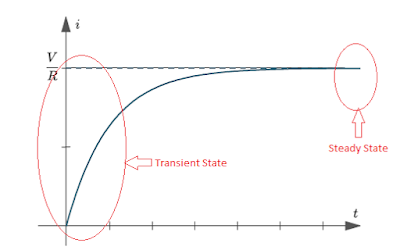The terms Steady State or Transient State is defined not only for electrical systems, but for many other physical systems also.
OR
Previously the circuit is switched off. Now it is suddenly switched on and kept on. What is the response i.e. output?
These types of responses are usually considered as transient responses.
In general transient response refers to the response due to change in equilibrium states.
Steady State occurs after the system becomes settled and at the Steady State system works normally. It depends on the forcing function i.e. source
Now, we will take a physical example to understand the difference between the two states.
Suppose we throw a stone into a stagnant lake. Before we throw stone, the lake is in equilibrium. When we throw the stone, the stone collides with the surface of water. Thus the momentum of stone is transferred to water. Water produces ripples. Ripples die out after some time and the stone sinks and the water is back to its stagnant state.
- Stone collides with the surface of water, forcing function which exists only for a certain small time. Like an impulse.
- Water produces ripples are the transient response.
- Ripples die out after some time and the water is back to its stagnant state is Steady State response.
Now we will go into the discussion back while taking an example of Electrical circuit. Consider the circuit given below.
If the battery is ON at t=0 and kept ON.
Inductor has no energy stored initially. So it has no voltage across it.
Inductor voltage = 0
Rate of change of current = 0
Initially current in inductor = 0
Energy stored in inductor = 0
As we know that Inductor does not allow sudden change in currents. So just after the moment when switch is ON, the current in inductor is zero. That means at t=0+ inductor acts as open circuit. But as the time passes inductor allows current. This happens until coil voltage drop is equal to applied voltage.
But after some time, i.e. when coil voltage drop is equal to applied voltage, then current flowing through the circuit is constant as inductor voltage is zero which means rate of change of current is zero. This state is called Steady State.
So if we solve the differential equation of the circuit, we’re actually finding the response as a function of time, which includes both transient and steady state response.
Thank you!



